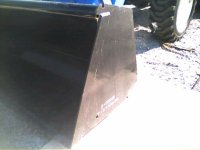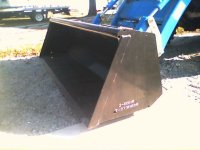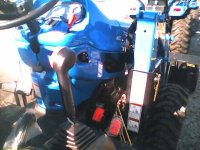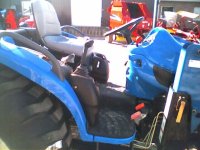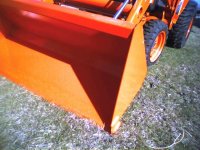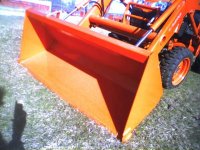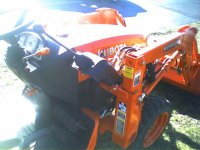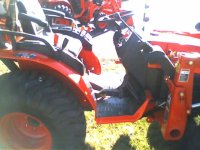Bob_Skurka
Super Member
- Joined
- Jul 1, 2003
- Messages
- 7,503
The lovely Mrs_Bob left for a week to visit the inlaws and as is my tradition, equipment usually ends up in my driveway while she is out of town. So I spent a good deal of time on dealer lots poking around and took a lot of photos.
I thought I would post the photos to let everyone see how different and still how similar tractors really are. No real editorial here folks. Just photos with some objective descriptions. I also, via PM, invited several other TBN members to photograph their tractors and post the pictures in this thread. All the pictures will show similar areas of the tractors. Bucket, loader area, operators station. ALL OF THE TRACTORS ARE ROUGHLY 30HP. NONE ARE BELOW 27, NONE ARE ABOVE 35.
BUCKETS will be described by SHAPE and by DUTY RATING.
Generally buckets are either "C" shaped or "L" shaped. "C" shaped buckets have a large top piece that is at least 6" deep. "L" shaped buckets generally look like a triangle or the capital letter "L"
BUCKET DUTY RATINGS will be described as LIGHT, STANDARD or HEAVY. LIGHT is defined as reinforced ONLY on the bottom cutting edge. STANDARD is defined as reinforced on EITHER the TOP or the SIDE (but not both) in addition to the bottom. HEAVY DUTY will be described as reinforced on the BOTTOM, the SIDES and the TOP. Reinforcement is defined as extra steel tubes (round or square) or 2 layers of steel plate welded in place, folds and dimples do not count as reinforcement for this definition.
FEL valve/hoses areas will be described in the following manner. The hoses, if they extend ABOVE the hood of the tractor & above the loader arm, will be described as UNPROTECTED. If they are below the hood & loader arm, they are PROTECTED. Operating valves can either be LOADER MOUNTED or FENDER MOUNTED. Operating the lever itself will be described as requiring a HORIZONTAL movement of your arm or a VERTICAL movement.
RIGHT SIDE photos of the operator's station will show the relative position of the loader valve and will show if the tractor can be entered and exited from both the right and the left side of the tractor or if the levers, valves, etc block right side access.
I had other pictures, but honestly could not figure out how to be totally objective so I am only sticking with 4 pictures per tractor.
Attached is Picture #1, it is the bucket detail of a New Holland TC35.
The bucket is a "C" shaped bucket.
The bucket is a "heavy duty" bucket since is has extra side plating and a steel tube welded under the top lip of the bucket.
I thought I would post the photos to let everyone see how different and still how similar tractors really are. No real editorial here folks. Just photos with some objective descriptions. I also, via PM, invited several other TBN members to photograph their tractors and post the pictures in this thread. All the pictures will show similar areas of the tractors. Bucket, loader area, operators station. ALL OF THE TRACTORS ARE ROUGHLY 30HP. NONE ARE BELOW 27, NONE ARE ABOVE 35.
BUCKETS will be described by SHAPE and by DUTY RATING.
Generally buckets are either "C" shaped or "L" shaped. "C" shaped buckets have a large top piece that is at least 6" deep. "L" shaped buckets generally look like a triangle or the capital letter "L"
BUCKET DUTY RATINGS will be described as LIGHT, STANDARD or HEAVY. LIGHT is defined as reinforced ONLY on the bottom cutting edge. STANDARD is defined as reinforced on EITHER the TOP or the SIDE (but not both) in addition to the bottom. HEAVY DUTY will be described as reinforced on the BOTTOM, the SIDES and the TOP. Reinforcement is defined as extra steel tubes (round or square) or 2 layers of steel plate welded in place, folds and dimples do not count as reinforcement for this definition.
FEL valve/hoses areas will be described in the following manner. The hoses, if they extend ABOVE the hood of the tractor & above the loader arm, will be described as UNPROTECTED. If they are below the hood & loader arm, they are PROTECTED. Operating valves can either be LOADER MOUNTED or FENDER MOUNTED. Operating the lever itself will be described as requiring a HORIZONTAL movement of your arm or a VERTICAL movement.
RIGHT SIDE photos of the operator's station will show the relative position of the loader valve and will show if the tractor can be entered and exited from both the right and the left side of the tractor or if the levers, valves, etc block right side access.
I had other pictures, but honestly could not figure out how to be totally objective so I am only sticking with 4 pictures per tractor.
Attached is Picture #1, it is the bucket detail of a New Holland TC35.
The bucket is a "C" shaped bucket.
The bucket is a "heavy duty" bucket since is has extra side plating and a steel tube welded under the top lip of the bucket.
